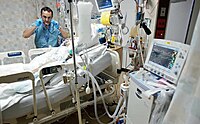
Photo from wikipedia
Critical Care Medicine www.ccmjournal.org 1013 Fifty years ago, patients admitted to an ICU with hypoxemic respiratory failure who received mechanical ventilation had a mortality rate of over 80%. There were… Click to show full abstract
Critical Care Medicine www.ccmjournal.org 1013 Fifty years ago, patients admitted to an ICU with hypoxemic respiratory failure who received mechanical ventilation had a mortality rate of over 80%. There were many different causes for this respiratory failure, and soon the acute respiratory distress syndrome (ARDS) was defined (1) and refined (2). ARDS has been repeatedly studied using multiple interventions to find ways to improve patient outcome. Mortality rates fell to ~20% but with both improvements in the treatment of other diseases such as hematologic malignancy, cancer and infection, and the capacity for multiple organ support, ICU clinicians now care for sicker patients with ARDS, and mortality rates have increased from 20% to 40% (3). A recent systematic review of mortality after ARDS by Máca et al (4) highlighted how study methodology alters the mortality rate. Control trials have a higher mortality rate than observational studies, whereas prospective studies have a different mortality rate to retrospective studies. ARDS due to a single specific diagnosis has a different mortality rate compared with groups of patients with ARDS due to multiple causes, with mortality rates varying from 11% to 87% being reported! Mortality rates are not constant because attitudes to end-of-life care and death may change over time; a single PICU compared outcomes from 1982 to 2005/6 and showed a decrease in mortality from 11% to 4.8%, but a concomitant increase in severe disability from 8.4% to 17.9%. Hence, the overall “bad outcome” had changed from 19.4% to 22.7% (5). Similar to all survivors of serious or prolonged care in ICU, survivors of ARDS, and their families, have an increased rate of long-term health problems. These include neurocognitive, physical, social, and emotional problems; rates vary from 70% to 100% at hospital discharge to ~50% at 1 year and ~20% at 5 years after discharge (6). Many recent studies have highlighted the burden of disease for these survivors and have relied on follow-up of at least 6 months using complex neuropsychologic and/or physical assessment (7). There are a variety of standardized tools available each with their particular strengths and weaknesses. These types of outcome assessments are often repeated over many years (8). In this issue of Critical Care Medicine, Villar et al (9) continue their series of articles on ARDS, with an interesting study. In this study by Villar et al (9), 778 patients with moderate-severe ARDS were assessed and had a mortality rate of 38.8%. These patients were then separated into two groups—those who would qualify for current trials of new treatments or those who would be excluded. The “eligible for trials of new ARDS treatments” group of 272 patients was then compared with the 506 patients “not eligible”; the mortality rate was 21.3% for the trial patients versus 48.2% for the “not eligible” patients. The cause of death was reviewed and recorded; refractory hypoxemia, as the main cause of death from ARDS, occurred in only 23% of patients, while ~49% died from multisystem organ failure, ~17% from refractory shock, and ~5% had brain death. It was highlighted that 37% of patients who died had important pre-existing comorbidities such as cancer or brain injury. Villar et al (9) found that the cause of death in these patients was not intractable hypoxemia but non-ARDS causes. Hence, they questioned whether overall survival is the correct outcome for trials of ARDS treatments. They also remind us that severe pre-ICU health state and the reason patients are admitted to ICU are very important in determining survival after ICU. Interestingly, some of the major trials of ARDS that have caused a change in clinical practice used all-cause mortality as the primary outcome. These include “the ARDSNet study” published in 2000, which showed that lower tidal volumes reduced mortality by 22% (10). A recent study, Neuromuscular Blockers in Early Acute Respiratory Distress Syndrome (ACURASYS) by Papazian et al (11), showed a hazard ratio of 0.68 for 90-day mortality if patients were given neuromuscular blockade for ventilation during the first 48 hours after randomization. Also, in a study by Guérin et al (12), 237 of 466 patients placed prone had a 28-day mortality rate of 16% compared with 32.8% in the control group. *See also p. 892.
Journal Title: Critical Care Medicine
Year Published: 2018
Link to full text (if available)
Share on Social Media: Sign Up to like & get
recommendations!